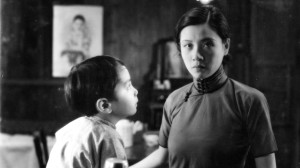Posted: October 20th, 2014 | No Comments »
Many people may be familiar with the 1952 Josef von Sternberg/Robert Mitchum film Macao, but an earlier French film, Macao – L’enfer du jeu (Gambling Hell in English) is an interesting movie for a number of reasons. Jean Delannoy began shooting the movie in 1939 before the fall of France but, with Paris occupied by the Nazis, he had to stop filming. The movie was an adaptation of Maurice Dekobra’s 1938 best selling book of the same title. The film is set in Macao and attempts (on French film sets) to recreate the casinos of the island (quite well) and the louche mix of gamblers, adventurers, gun runners and dope smugglers.
However, two versions of the film exist – the first, pre-war version, starred Erich Von Stroheim. However, he was an outspoken opponent of Nazism and the scenes in which he appeared were redacted during the Occupation, and reshot with the actor Pierre Renoir (son of the painter, older brother of the film director, both called Jean) instead of Von Stroheim. Parisian starlet of the day Mireille Balin was the lead actress and Sessue Hayakawa the lead Asian actor (he was born in Japan though worked all over Europe and America, was trapped in France by the Nazi invasion and survived by selling watercolours and joining the French Resistance) in the film (doomed to death of course, but a major part). The Renoir version was released in France in 1942 during the occupation and then, in 1945, the original Von Stroheim version was released eventually. It’s really rather good….
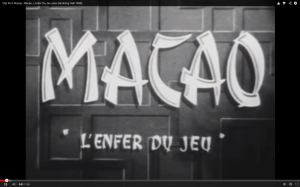
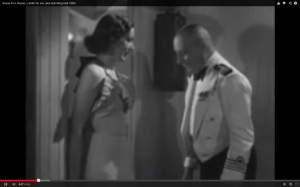 Balin and Von Stroheim
Balin and Von Stroheim
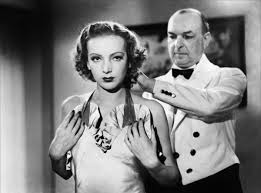 Balin and Renoir
Balin and Renoir
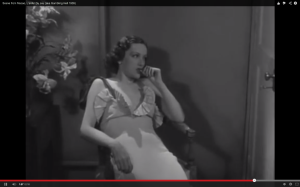 Balin all alone
Balin all alone
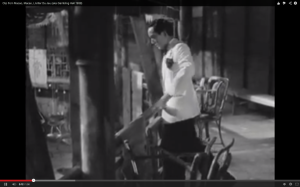 Hayakawa as Ying Tchai in a dapper white suit looking over the balcony of a Macao casino
Hayakawa as Ying Tchai in a dapper white suit looking over the balcony of a Macao casino
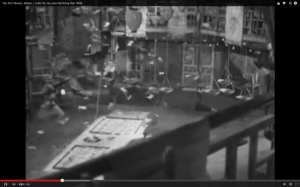 The casino itself with the ubiquitous roulette wheels and baskets to move money and chips up and down between the croupiers and punters, an accurate feature of Macao casinos of the time, now sadly replaced by Vegas style glitzy nonsense
The casino itself with the ubiquitous roulette wheels and baskets to move money and chips up and down between the croupiers and punters, an accurate feature of Macao casinos of the time, now sadly replaced by Vegas style glitzy nonsense
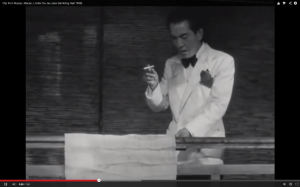 Hiyakawa has a smoke
Hiyakawa has a smoke
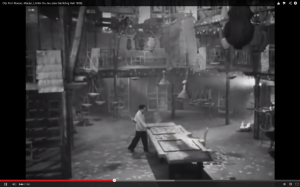 Hiyakawa burns the casino shortly before killing himself
Hiyakawa burns the casino shortly before killing himself
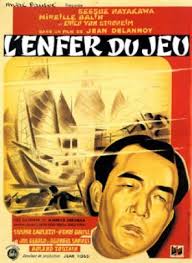 Film poster highlighting Hiyakawa
Film poster highlighting Hiyakawa
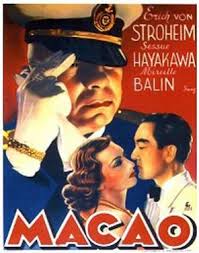
Film poster with Von Stroheim – the almost kiss pictured between Balin and Hiyakawa would have been unimaginable on an American film poster of the time
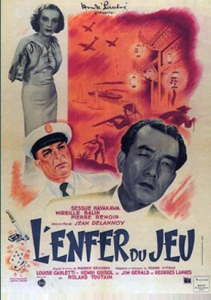 Film poster with Renoir – during the war guns and bombers were stronger motifs than afterwards – note the junks and non-military motifs on the poster above issued in 1945
Film poster with Renoir – during the war guns and bombers were stronger motifs than afterwards – note the junks and non-military motifs on the poster above issued in 1945
Posted: October 19th, 2014 | No Comments »
A bit of entertainment for your weekend – Fred Astaire and Lucille Bremer go down East and get the Limehouse Blues with Pearlies, Cockneys, swells and guttersnipes…and a lot of fans….plenty Yellow Face but some great dancing in this insert into 1946’s Zeigfeld Follies…
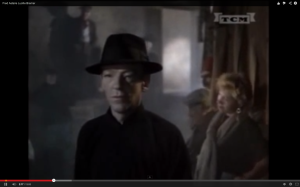
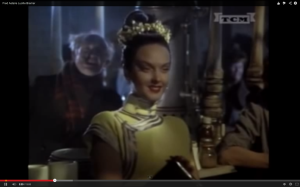
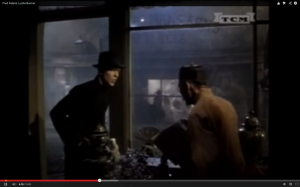
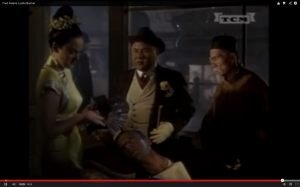

Posted: October 17th, 2014 | 1 Comment »
The apparent appearance of hired thugs, probably from Guangdong organised crime gangs, on the streets of Hong Kong harassing the democracy movement has been blamed on the Mainland Chinese government’s tendency to use such people to stir up trouble and chaos at everything from property development disputes (beating residents slow to leave) to labour strikes (beating up workers) in recent years. As well as a rather handy non-uniformed enforcement body, the thugs provide the government with the opportunity to claim divisions within society and justify the need for state forces to step in to stop the chaos. Some in the foreign media and casual observers have found this tactic hard to understand and difficult to countenance. However, there is a long history of China’s post-1911 governments using triads, gangs and hired thugs to intervene and either stir up, or repress, volatile situations and deal with perceived “enemies” of the state. The roots of the triads and other secret societies mostly reach back anti-Qing organisations, but we don’t need to go quite that far back…
So let’s go back to 1927….and Shanghai….
To cut a long story short (Chinese history stories are always long of course) Chiang Kai-shek, at the end of his Northern Expedition, wished to purge Shanghai of communists, leftists and unions. He needed help in the International Settlement and Frenchtown where his troops could not freely roam (as the PLA cannot in Hong Kong). The Green Gang and Red Gang offered to help. In April 1927 hundreds of left wing activists (some say over a thousand – the sources are confused to say the least – Edgar Snow claimed between 5,000 and 10,000 people were executed, but he had his own agenda as we all know) were killed, mostly by Green and Red Gang members wearing overalls and white armbands saying “worker”. They were hunted down and either shot or beheaded in the street, snipers shot more from rooftops.
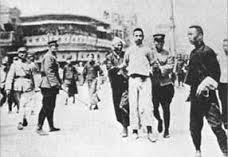
Nobody came out of the events of April 1927 well. The deal to suppress the Left involved all the major players in Shanghai. Du Yuesheng, the Green Gang leader, organised his own militia – the China Mutual Progress Association – while the French Consul General called for a public struggle against the communists with French police guarding the headquarters of Du’s Association and supplying them with guns. Du then used his contacts with Captain Fiori, the Frenchtown Chief of Police, to meet with Sterling Fessenden, the Chairman of the Shanghai Municipal Council (SMC) in the International Settlement. Fessenden, a short, plump American, persuaded the SMC to allow Du’s thugs passage through the International Settlement so they could slaughter the Leftists. Probably like today’s Communist Party politicians in Beijing, Chiang would have liked to think either of the gangs as (misguided) patriots to be worked with to do a good thing or as thugs he temporarily had to work with to achieve the right ends. However, the truth was that the nationalist’s links with the Green Gang went back to the founding of the Republic when Dr Sun’s confidant Chen Qimei had enlisted Green Gang support to seize Shanghai for the nationalist cause.
![shanghai-1927-beheading[1]](http://www.chinarhyming.com/wp-content/uploads/2014/10/shanghai-1927-beheading1-300x159.jpg)
The problem in 1927, and one presumably the Party in Beijing will have to deal with now in southern China, is what price the gangs extract for their services? In 1927 political insiders were not that surprised that the first civilian visitor to see Chiang in Shanghai after the putting down of the left was Huang Jinrong, the boss of the Red Gang. A deal had been done – the gangsters would back Chiang with thugs and arms in return for immunity and continued control of Shanghai’s lucrative drugs business. The government’s deal with the thugs was not necessarily much of a secret – consider a Secret General Staff Intelligence Report, Shanghai entitled ‘Chinese Secret Societies and Political Organisations’ from March 1937 (which anyone can read at the UK National Archives by calling up file WO 106/5375):
‘It is generally believed that in exchange for assistance rendered to him, General Chiang promised the Green Party in Shanghai a monopoly of the opium business, and it was not long before the party enjoyed the reputation of a gang of racketeers whose activities were on a par with those of their Chicago counterparts – the Capone gang. Nothing of importance happened in Shanghai in which could not be found the influence of the Green Party, workers organisations and labour unions being completely under its domination.’
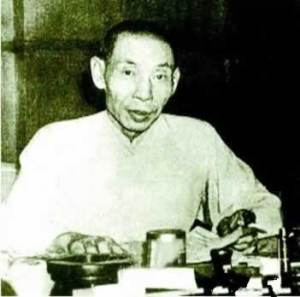 Du Yuesheng – Gang leader who hired out thugs to the government – but not without a price
Du Yuesheng – Gang leader who hired out thugs to the government – but not without a price
Of course later many of the thugs who cut their teeth in 1927 became even more formally politically aligned. After Du Yuesheng left Shanghai in 1938 (following the Japanese invasion) and headed to Hong Kong and Chongqing the Green Gang’s power collapsed in the city. Du eventually died in Hong Kong after time in Taiwan after 1949. With the Green Gang effectively neutered in Shanghai after 1938 many of his thugs moved effortlessly into the ranks of collaborator Wang Jing-wei’s puppet pro-Japanese government where they continued to operate as thugs, extortioners and murderers. After the war the Kuomintang government faced with weakened ranks after fighting the Japanese and the insurgent communist threat made contact again with those remnants of the old Green and Red gang as well as other gangs – the KMT in Shanghai in 1946 reactivated their branch of the Ang Bin Hoey and Hung League secret societies in order to fight the communists.
When current events in Hong Kong finally play out and the gangs and thugs are told to return to their lairs in Mongkok, or across the border in Guangdong, what price will they exact for their “loyalty” during these times?
Posted: October 16th, 2014 | No Comments »
I blogged the other day over at the Los Angeles Review of Books China blog on some comparisons between inter-war Istanbul and Shanghai, by way of slipping in a review of Charles King’s excellent book Midnight at the Pera Palace: The Birth of Modern Istanbul. I happened to mention in that review that Shanghai’s equivalent of the Pera Palace in the 1930s was probably Sir Victor Sassoon’s Cathay Hotel (now the rather less exciting Peace Hotel) and that that hotel had its own novel – Vicki Baum’s Shanghai ’37 (sometimes called Shanghai Hotel). I’m going to assume a hefty percentage of China Rhyming readers will know Baum’s novel, but I thought this as good a opportunity as any to slip in a picture of its rather good original cover…
What I didn’t realise until I happened to check Baum’s bio was that she was an early advocate of women’s boxing and, in the 1920s, trained with the Turkish prizefighter Sabri Mahir at his Studio for Boxing and Physical Culture in Berlin. So there actually was a Turkey/Shanghai link in Baum’s life.
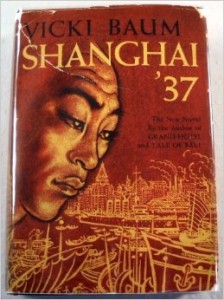
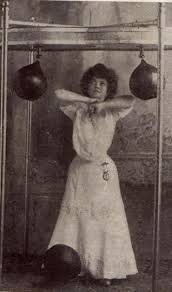
Baum in a Berlin boxing gym in the 1920s
And a few other Shanghai’37 (Shanghai Hotel covers)

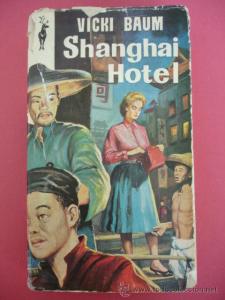
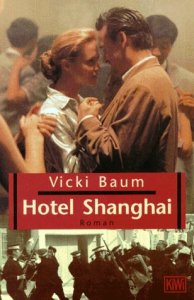

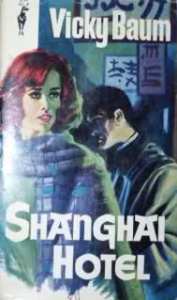
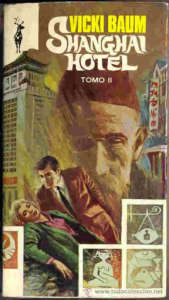
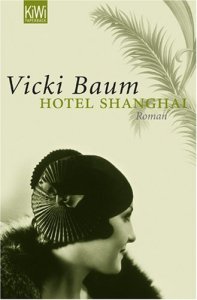
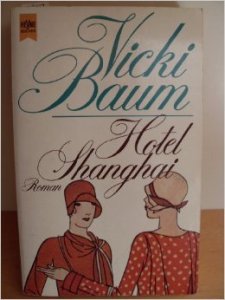
Posted: October 15th, 2014 | No Comments »
Imperial Splendor and a Life in Ruins: A guided tour of Yuanming Yuan (the Old Summer Palace)

WHEN Â Â Â Saturday, October 18, 2014, 2.00 PM – 6.30 PM (details below)
WHERE Â YuanmingYuan (the Old Summer Palace), starting at the East Gate
COST    Members RMB 100, non-Members RMB 150  (prices include entrance tickets but NOT bus transport – see note below)
Background
The Yuanming Yuan, “garden of perfect brightnessâ€, symbolizes the bandwidth of European- Chinese relations, as in its history we see cultural exchange as well as conflict. In its heyday during the reign of Emperor Qianlong, its buildings were designed in Western rococo style by European Jesuits in collaboration with Chinese architects. 100 years later, on October 18, 1860, British troops (who had allied with the French for this expedition) put the Yuanming Yuan to the torch. The ruins of the buildings in Western style became the distinctive landmark of the Yuanming Yuan.
Our guide and cultural interpreter is Dr. Ines Eben v. Racknitz, who will lead a tour of the ruins of the Yuanming Yuan, explaining its role in the Imperial history of China, the tragic events of 1860 that led to its destruction, and contemporary issues of conservation and restoration of this exceptional Chinese garden and monument.
Dr. Ines Eben von Racknitz currently teaches Chinese history at Nanjing University, focusing on late Qing, as well as global, history. Â Her PhD thesis (now published as a book) focuses on the China expedition of 1860 and the destruction of the Yuanming Yuan; she is also an expert on European colonialism in China.
IMPORTANT NOTE ON POSSIBLE BUS: If demand is sufficient, RASBJ can arrange a bus departing from the Hilton Hotel on the E. Third Ring Rd., 400 meters north of Lufthansa Center.  Cost depends on numbers, though will likely approximate taxi fare to/from central Beijing. But we need to decide SOON. If you’re willing to pay for bus transport, please email membership@rasbj.org NO LATER THAN SEPT. 30, specifying how many seats. If bus is viable, RASBJ will e-mail you to confirm, with exact cost and payment method. THOSE WANTING A BUS MUST PAY FOR IT BY OCT. 11; the bus cost will not be refundable.
TIMETABLE (INCLUDING BUS OPTION):
2.00 PM —depart Hilton Hotel, N. Third Ring Rd. by bus, with Prof. v. Racknitz
3.00 PM —arrive YuanmingYuan East Gate
3.15-5.15 PM — starting at the East Gate, tour includes view of model, ruins, new exhibitions and other sites
5.30 PM —depart East Gate by bus
6.30 PM —arrive Hilton Hotel  by bus
Numbers will be limited; RASBJ Members have priority until September 30th.
Location and access: see map below for location. There is no direct public transport to the East Gate. From central Beijing, taxi takes approx. 1 hour and costs approx. RMB70 each way.
REPLY–Please email membership@rasbj.org to RSVP , stating whether you want to pay for seats on a bus, and if so how many.Â
Posted: October 14th, 2014 | No Comments »
Peipei Qiu’s Chinese Comfort Women: Testimonies from Imperial Japan’s Sex Slaves may not be comfortable reading but it is essential….I would also point China Rhymers to this extended review piece on the book from Megan Shank in the Los Angeles Review of Books…

During the Asia-Pacific War, the Japanese military forced hundreds of thousands of women across Asia into “comfort stations” where they were repeatedly raped and tortured. Japanese imperial forces claimed they recruited women to join these stations in order to prevent the mass rape of local women and the spread of venereal disease among soldiers. In reality, these women were kidnapped and coerced into sexual slavery. Comfort stations institutionalized rape, and these “comfort women” were subjected to atrocities that have only recently become the subject of international debate.
Chinese Comfort Women: Testimonies from Japan’s Imperial Sex Slaves features the personal narratives of twelve women forced into sexual slavery when the Japanese military occupied their hometowns. Beginning with their prewar lives and continuing through their enslavement to their postwar struggles for justice, these interviews reveal that the prolonged suffering of the comfort station survivors was not contained to wartime atrocities but was rather a lifelong condition resulting from various social, political, and cultural factors. In addition, their stories bring to light several previously hidden aspects of the comfort women system: the ransoms the occupation army forced the victims’ families to pay, the various types of improvised comfort stations set up by small military units throughout the battle zones and occupied regions, and the sheer scope of the military sexual slavery-much larger than previously assumed. The personal narratives of these survivors combined with the testimonies of witnesses, investigative reports, and local histories also reveal a correlation between the proliferation of the comfort stations and the progression of Japan’s military offensive.
The first English-language account of its kind, Chinese Comfort Women exposes the full extent of the injustices suffered by and the conditions that caused them.
Posted: October 13th, 2014 | 22 Comments »
So series 1 of the excellent Birmingham gang saga Peaky Blinders featured a hyper realised Chinatown and a plenty of sucking on the good old style opium pipe. But now in series 2 we’re in the mid-1920s and we’re in London and the boys are snorting back long lines of “Tokyo”, which we can safely assume to be cocaine. OK, cocaine was a big 1920s drug and London nightclubs were the place to get into it, but ” Tokyo”? I’ve never heard that slang name for coke and I think I’ve heard most – anyone?
According to the programme notes for Peaky Blinders series 2, in an interview with Colm McCarthy, the director, he claims, “Tokyo is the street name for cocaine at the time” (the time being 1924). I can’t find any references to Tokyo as a slang name for coke in the 1920s in either the UK or US so I’m thinking this is made up – bit, if so, why, it’s not as if cocaine hasn’t got enough slang names from the period.
Anyway, just being anal as ever I suppose – it’s all great TV!

The boys have come down to London…and got a taste for a line of “Tokyo”….
.
Posted: October 12th, 2014 | No Comments »
As part of the BFI’s London Film Festival Ruan Lingyu’s amazing silent The Goddess has been remastered and shown with a live soundtrack….October 14th, 7.30, Queen Elizabeth Hall, South Bank
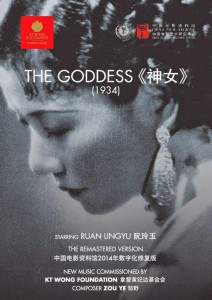
 Hayakawa as Ying Tchai in a dapper white suit looking over the balcony of a Macao casino
Hayakawa as Ying Tchai in a dapper white suit looking over the balcony of a Macao casino The casino itself with the ubiquitous roulette wheels and baskets to move money and chips up and down between the croupiers and punters, an accurate feature of Macao casinos of the time, now sadly replaced by Vegas style glitzy nonsense
The casino itself with the ubiquitous roulette wheels and baskets to move money and chips up and down between the croupiers and punters, an accurate feature of Macao casinos of the time, now sadly replaced by Vegas style glitzy nonsense Hiyakawa burns the casino shortly before killing himself
Hiyakawa burns the casino shortly before killing himself Film poster highlighting Hiyakawa
Film poster highlighting Hiyakawa Film poster with Renoir – during the war guns and bombers were stronger motifs than afterwards – note the junks and non-military motifs on the poster above issued in 1945
Film poster with Renoir – during the war guns and bombers were stronger motifs than afterwards – note the junks and non-military motifs on the poster above issued in 1945











![shanghai-1927-beheading[1]](http://www.chinarhyming.com/wp-content/uploads/2014/10/shanghai-1927-beheading1-300x159.jpg)
















